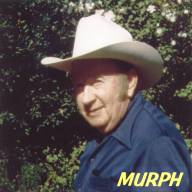
Joaquin Murphey
Here is Joaquin Murphey's pedal steel copedent, as built by Chas Smith:
1 2 3 4 5 6 1 G (.013) 2 E (.016) Eb 3 C (.020) C# 4 A (.024) Bb 5 G (.028) F# 6 E (.032) Eb 7 C#(.038) C 8 C#(.068) C 9 B (.020)
On the Steel Guitar Forum, Chas Smith wrote:
This is his original setup that was changed to adding the, 2nd string, E ->F on pedal 2 and the, 1st string, G->G# on pedal 3. Mike [Johnstone] may have also added the K of both C#'s ->D. Joaquin had lost the dexterity in his legs so Mike fitted the guitar with knee levers and moved the pedals so he could have two for each foot (he didn't use a volume pedal).
Michael Johnstone added:
A little more about Murph's guitar. The guitar was originally built to Joaquin's specs w/6 pedals and no knee levers. But as Winnie [Winston] mentioned, Murphey had another custom built guitar in the late 60s-early 70s made for him by a fellow out of Burbank named "Woody". It was a single 8 w/a 22" scale and 6 pedals, Sierra styled folding legs and had a copedant just like the setup in Chas' post except w/out the low octave C# string. BTW, he had been playing the same tuning w/out pedals on his Bigsby and other guitars since the late 40s. Murph played Woody's guitar for a number of years around L.A. as well as at Scotty's convention in 1976 and on the Scotty produced LP that he cut in Nashville on his way back from the convention. Incidently, that was the only time Murph played Scotty's event.
When Woody died, his children repossesed the guitar from Murph by force - even though Woody had plainly meant it to be a gift by all accounts. Heartbroken, out of work and broke, Murph started drinking heavily and washed cars for a living till 1995 when I met him and we started hanging out together. After that, I introduced him to Chas and at that point Chas and I decided to get him a good guitar and get him back on his feet and playing again.
And that's how Chas came to build the guitar that Joaquin played for the rest of his life. Murph had his own ideas about steel guitar design. He wanted 9 strings spaced 3/8" at the changer AND the nut - so the strings were totally parallel all the way down their length. He wanted 6 pedals just like the "Woody" guitar and he had specific ohms and windings specs for the pickup which I can't recall just now but I'm not sure Chas stuck with them anyway because he ended up having Dan Sheilds wind basically a replica Bigsby pickup in a 9 string configuration. And of course he had the now famous high B string as his 9th string - a sort of Maj7th chromatic string on the wrong end of the guitar.
After Murph played the new guitar for a while,he expressed to me that due to his advanced age, he was having difficulty getting around on the 6 pedals. He said he envied E9 players whose foot seemed to hover over the same 2 or 3 pedals. I told him he should try knee levers and at first he thought it would be too complicated for him but after much urging he decided to try it. So I took pedals 5 & 6 off and put them on LKR and RKL respectively. Then I moved pedals 3 & 4 to positions 5 & 6 leaving a gap of two pedal spaces in the middle of the pedal rack. At the same time,I added a 3rd lever (LKL which pulled the 3rd string up to D) which he came to use quite a bit. Not long after that,I asked him if he wanted to try pulling the 2nd string (E) up to F on the 2nd pedal to go with lowering string 6 (E) to Eb so as to have what all of us have come to consider a standard C6 pedal. When he tried it he slapped his head and said "That's so obvious - why the hell didn't I think of that!" I wanted to add a 4th lever but neither of us could think of what else to add that he couldn't already get. Let me add that this man KNEW the C6 tuning backwards, forwards and sideways and could get so much going on without pedals that it staggered my imagination. Also - and I've said this before, his left hand bar manipulation and right hand picking finesse bordered on prestidigitation. He seemed to be drawing circles around the strings with the tip of the bar and twiddling his picks while smooth, deep bebop lines were pouring out of his hands.
Since he didn't use a volume pedal, he was able to play a pair of pedals with each foot without jumping around or having to look at his feet - and he came to love the concept of knee levers. I must add that like a lot of C6 players he did not use pedals much when soloing single string but exploited them heavily for chord work and often said that he wished he had had a guitar of this capability when was in his prime. -MJ-
Here is the copedent as Michael describes it, with pedals 3 & 4 removed:
LKL 1 2 LKR RKL 5 6 1 G (.013) 2 E (.016) F Eb 3 C (.020) D C# 4 A (.024) Bb 5 G (.028) F# 6 E (.032) Eb 7 C#(.038) C 8 C#(.068) C 9 B (.020)
This is what you hear on the Murph CD.